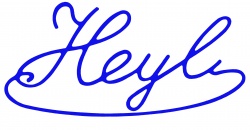
Article
Medico-Social Profile of Bulgarian Female Soldiers
The authors presents part of the results of a survey conducted in 2009–2011 among two groups of respondents:
646 female soldiers and; 178 civilian women whose occupations require wearing of a uniform.
Introduction
The current geopolitical situation has witnessed a change in terms of the nature of military conflicts. While the probability of global military conflict decreases – including the likelihood of a large-scale use of weapons of mass destruction, local conflicts prevail. Peace enforcement and peacekeeping operations are carried out in unstable zones. Servicemen have a decisive role in eliminating the impact of non-military crises such as natural disasters, industrial accidents, and terrorist attacks. Servicewomen’s professional participation in all these activities is an important feature in this regard.
Global socio-economic changes have also reflected on Bulgaria, prompting changes in the core principles and priorities of the Bulgarian army. The military recruitment process in the Republic of Bulgaria is based on the principle of non-discrimination. The Bulgarian military is open to all candidates eligible under the terms and conditions needed to assume a particular office, regardless of their gender.
The integration of women and recognition of their abilities in what was considered as a purely man’s job until recently is a difficult but still evolving process on a global scale.
Goal
The current work aims to determine and explain several important factors concerning Bulgarian military servicewomen’s reproductive health, professional and daily life status. Another goal is to highlight the necessity for them to be understood and to find a solution of any possible problems.
Materials and Methods
The author presents part of the results of a survey conducted in 2009-2011 among two groups of respondents:
- 646 female soldiers;
- 178 civilian women whose occupations require wearing of a uniform.
The results were confirmed by statistical methods.
Results and Discussion
Distribution by Age
1. The following figure (fig. 1) shows the distribution of female soldiers in Bulgarian army by age.
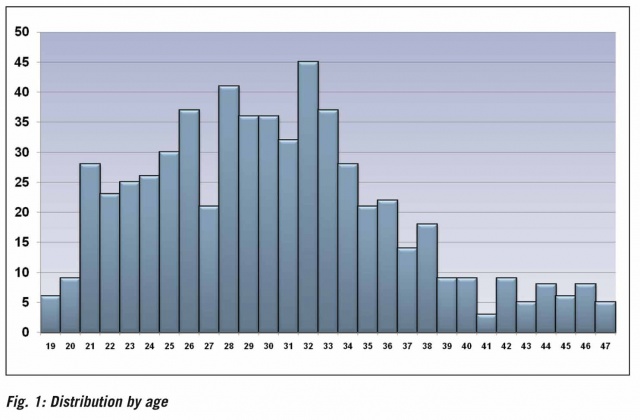
From the chart it can see that, the average age of female soldiers is 32 years. The average age of civilian women is 41 years (P < 0.0001).
2. Family Status
The following figure (fig. 2) shows the data of family status of respondents.
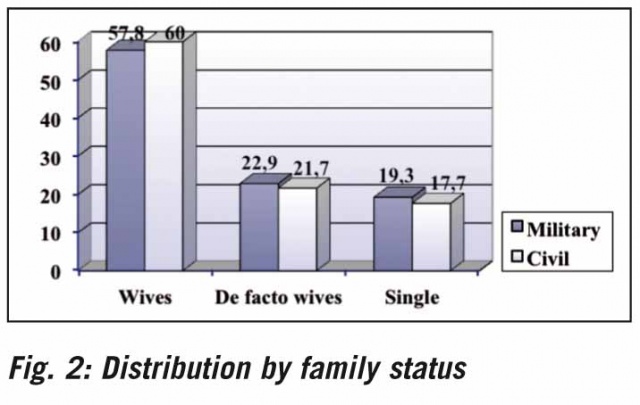
If we collect the percentage of respondents who are married and who have a permanent partner, we will see that the majority of women are living in family configuration. The majority of both military (81%) and civilian (82%) women are either married or “de facto wives”.
3. Motivation for the Choice of Profession
Motivation is very important to all human achievements. In order to define respondent’s motivation in their professional choice, they were given 5 possible answers: 1 – financial reasons, 2 – social gains, 3 – family profession continuity 4 – because of the challenge, 5 – other reasons.
The next figure (fig. 3) shows the distribution of respondents according to motivation for the choice of profession.
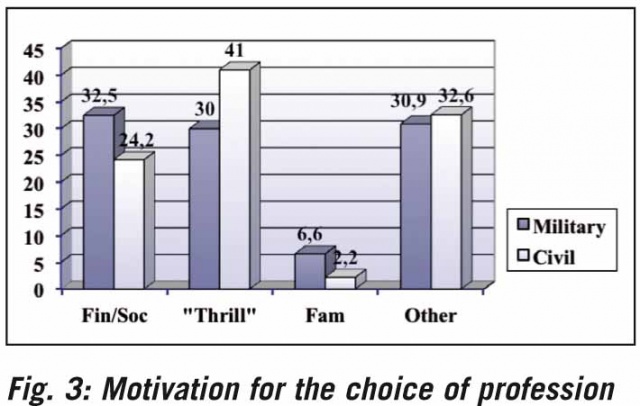
One third of female soldiers (32%) explain their professional choice with financial and/or social reasons. Among civilian women the respective proportion is significantly lower – 24%. The differences are statistically significant (P < 0.0001).
No statistically significant difference exists between female soldiers and civilian women as far as the reason “Thrill” is concerned.
On the basis of data analysis of the available literature we could conclude that, in spite of the differences such as national mentality, cultural traditions, age, family status and other factors, there is a big resemblance between the motives of servicewomen of different nationalities to enroll in the military.
4. Self-assessment of Physical Loads v/s Males
One of the essential directions of the current reform in Bulgarian army is the achievement of high professional skills among the military staff, especially good physical shape and psycho-emotional stability. The next figure (fig. 4) shows the distribution of respondents according to their Self-assessment of physical loads v/s males.
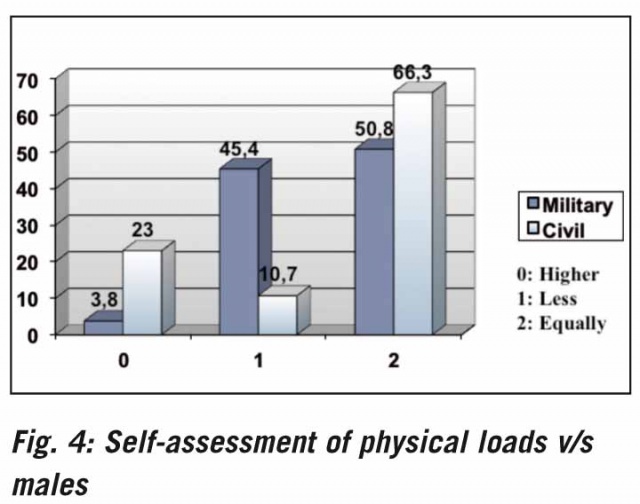
Female soldiers who assess their physical strain as lower than that of male are (45%). Most of the respondents are convinced that physical strain of both genders is symmetrical.
The differences are statistically significant
(P < 0.0001).
5. Self-Assessment of Psycho-Emotional Loads v/s males
The next figure (fig. 5) shows the distribution of respondents according to self-assessment of psycho-emotional loads v/s males
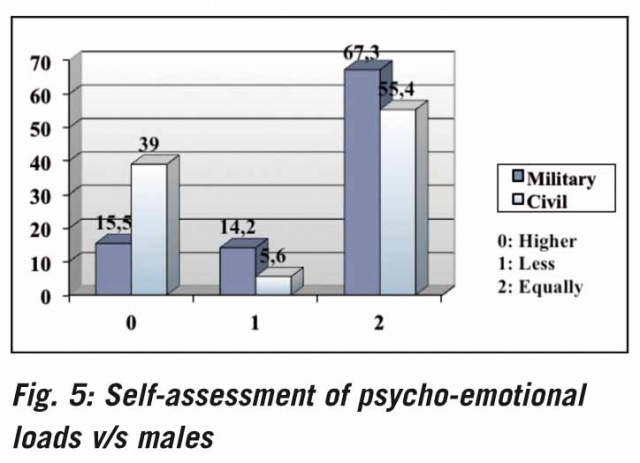
As far as psycho-emotional strain is concerned, the two groups of respondents display considerable differences. Psycho-emotional strain is assessed as:
nnhigher in females by 16% of military and 39% of civilian;
nnsymmetrical in both genders by 68% of military and 55% of civilian.
The differences are statistically significant
(P < 0.0001).
6. Satisfaction with Evaluation by Third Parties
Professional satisfaction is an important element of our life. The following figure (fig. 6) shows the data of satisfaction with evaluation by third parties.
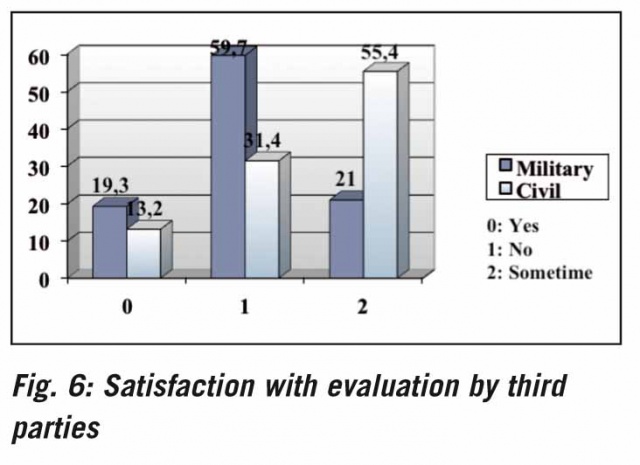
Female soldiers are less satisfied with the “acceptance of their performance by third parties” than women involved in civilian professions – 60% vs. 31%
The differences are statistically significant
(P < 0.0001).
7. Information on how to Cope with Gynaecological Disorders during Field Activities
Military women train on places far away from the cities, they do not have a qualified medical service there. The following figure (fig. 7) shows the data of information on how to cope with gynaecological disorders during field activities.
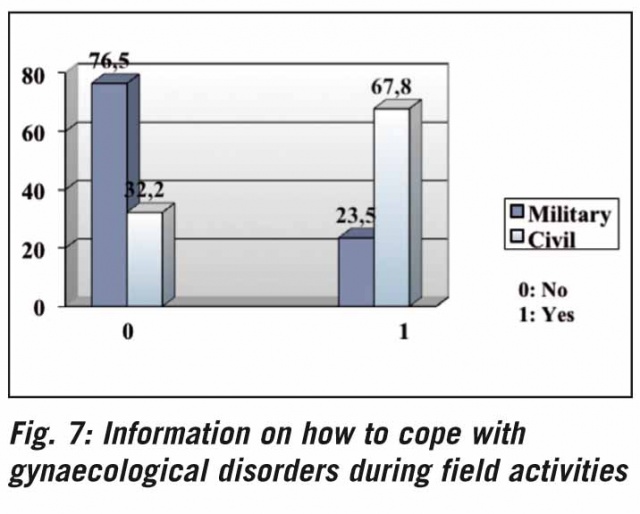
The vast majority of female soldiers (76.5%) consider they lack enough information on how to cope with gynaecological disorders during field operations.
The differences are statistically significant
(P < 0.0001).
8. Fitness of Uniforms to the Specifics of the Female Body
Military uniforms are incompatible with the female body so Bulgarian women soldiers find it difficult to perform their professional duties. The results are shown on the next figure (fig. 8)
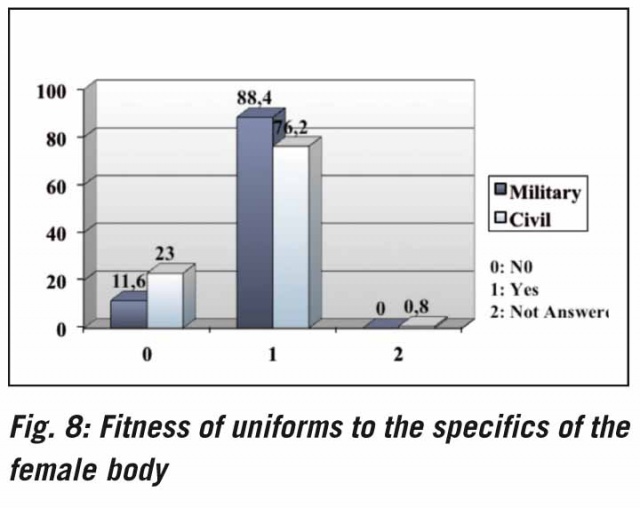
The majority of respondents believe that their uniforms must take into considerations the specifics of the female anatomy (76% civilian and 90% of the military).
According to (Herbert 1993) women are being constantly reminded of their sex by the different physical standards and badly fitting uniforms[4].
9. Facilities for Personal Hygiene
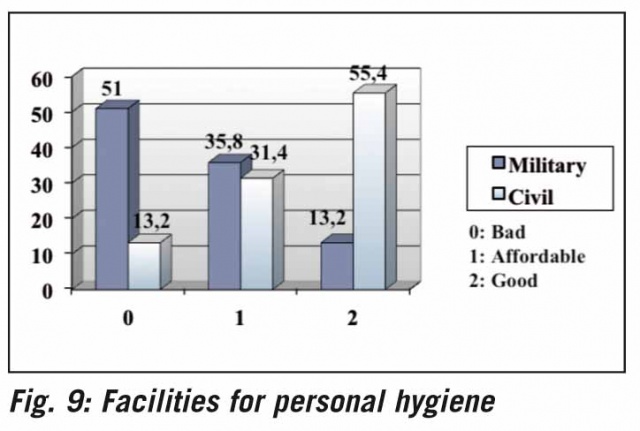
Military women train on places far away from the cities. Sometime they do not have facilities for personal hygiene. The following figure (fig. 9) shows the data of satisfaction with facilities for personal hygiene of respondents.
Over 50% of female soldiers (opposed to 13% of civilian women) assess facilities for personal hygiene at the workplace as “poor”.
The differences are statistically significant
(P < 0.0001).
Summary
The author presents part of the results of a survey conducted in 2009-2011 among two groups of respondents:
1. 646 female soldiers;
2.178 civilian women whose occupations require wearing of a uniform.
The average age of female soldiers is 32 years. The average age of civilian women is 41 years (P < 0.0001).
The majority of both military (81%) and civilian (82%) women are either married or “de facto wives”.
One third of female soldiers (32%) explain their professional choice with financial and/or social reasons. Among civilian women the respective proportion is significantly lower – 24% (P < 0.0001). No statistically significant difference exists between female soldiers and civilian women as far as the reason “Thrill” is concerned.
Women involved in civilian professions are more satisfied with the “acceptance of their performance by third parties” than female soldiers – 55% vs. 21% (P < 0.0001).
Female soldiers who assess their physical strain as higher than the physical strain of their male counterparts are a minority (4%). Much more (23 %) of civilians assess their physical strain as higher than that of males (P < 0.0001). Most civilian women (66%) are convinced that physical strain of both genders is symmetrical.
As far as psycho-emotional strain is concerned, the two groups of respondents display considerable differences. Psycho-emotional strain is assessed as
nnhigher in females by 18% of military and 39% of civilian respondents;
nnlower in females by 14% of military and 6% of civilian respondents;
nnsymmetrical in both genders by 68% of military and 55% of civilian respondents.
All the above differences are statistically significant (P < 0.0001).
The vast majority of female soldiers
nnconsider they lack enough information on how to cope with gynaecological disorders during field operations (76%);
nnbelieve that their uniforms must take into consideration the specifics of female anatomy (88%).
Over 50% of female soldiers (opposed to 13% of civilian women) assess facilities for intimate hygiene at the workplace as “poor”.
Conclusions
1. The majority of female soldiers explain their professional choice with financial and/or social reasons.
2. Women involved in civilian professions are more satisfied with their profession than female soldiers.
3. The majority of female soldiers assess facilities for personal hygiene at the workplace as “poor”.
4. The majority of respondents believe that their uniforms must take into considerations the specifics of female anatomy. n
References: ref@mci-forum.com
Date: 07/21/2016
Source: MCIF 3/16
